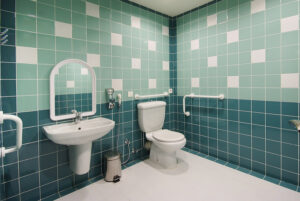January is National Bath Safety Month. While many articles will be written about the importance of keeping babies and toddlers safe in the bathroom, it’s also essential to keep the bathroom safe for your senior. As you care for an elderly loved one, her needs and abilities may change over the years, making it essential that you and her companion care at home providers continually review her bathroom to make sure it is a safe place for her to use.
Here are some key areas for you and their companion care at home aides to look at and make sure that they are safe.

The floors and the water
The floors and the water
For the main flooring, make sure any rugs are non-slip and don’t present a tripping hazard. If your loved one uses a walker or cane to get around or needs the help of a companion care at home provider, you might want to remove all rugs from the floor.
For the bathtub, make sure the floor of the bathtub and shower are non-slip. You can purchase slip-resistant pads to place on the floor or you might need to have someone like a companion care at home provider nearby at all times to help with balance while in the bath or shower. Adding a shower stool can also help with stability.
Check your thermostats on your water so that your elderly loved one doesn’t accidentally turn up the hot water too high. Elderly skin can be thinner and most sensitive, making it easier to get scalded so keep those temps down to prevent a painful accident.
The bath/shower and the toilet
As mentioned earlier, make sure the flooring is safe and not slippery. If getting in and out of the tub has become more difficult in later years, you can install railings for your loved one to hold onto and pull herself up with. Your companion care at home team can also provide someone who will sit nearby as your loved one bathes, to help her in and out of the tub if she is comfortable with that.
If your loved one has gotten to the point where standing up from a seated position or getting down into a seated position is tough, you might need to add some adaptive tools around the toilet so she can easily sit down and get back up. It’s dangerous for her to try to leverage a nearby sink or the wall to help herself maneuver the toilet. Instead, look at adding some support bars around the toilet so that she can safely put all of her weight on when she needs to sit and get back up.
Have proper lighting
If your loved one needs to use the bathroom often in the middle of the night, have small light sensors that will keep the area lightly lit up when she enters. She won’t want a full-on light to help her see, but some night lights to illuminate the room slightly will help prevent her from slipping on something she doesn’t see on the floor. Speaking of which, make sure to keep items off of the floors. They can easily provide a tripping hazard.
Knowing your loved one’s abilities will help you make the best adaptations to her bathroom to keep it safe for her to use.

